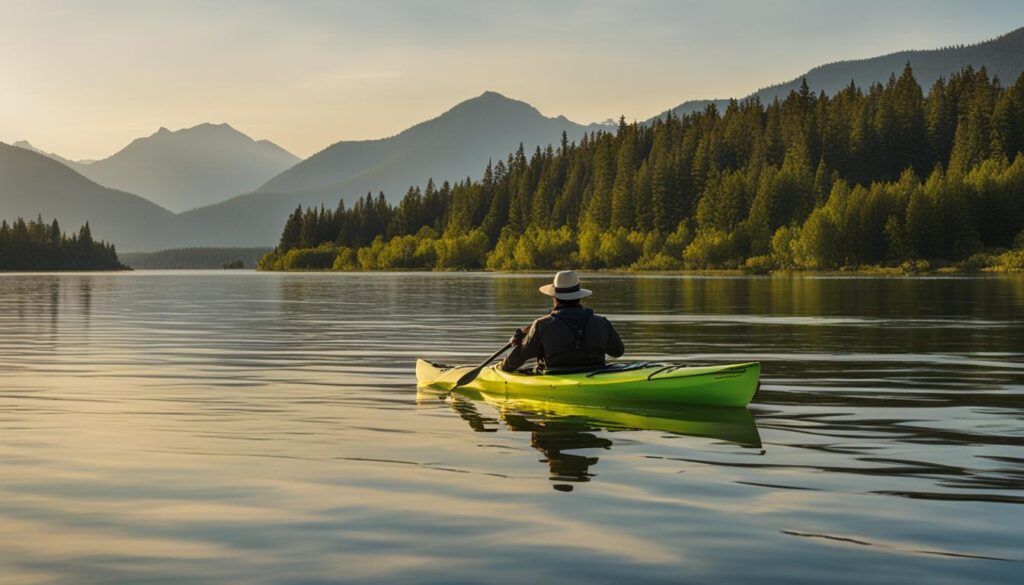Understanding proper kayaking etiquette is essential for a safe and enjoyable experience on the water. Whether you’re a beginner or an experienced paddler, observing kayaking etiquette is crucial in showing respect to other kayakers and the environment. In this article, we will explore the key do’s and don’ts of kayaking etiquette, including wearing appropriate safety gear, being mindful of water conditions, and respecting private property in sensitive kayaking environments.
Key Takeaways:
- Kayaking etiquette is important for a safe and enjoyable kayaking experience.
- Responsible kayaking behavior includes wearing appropriate safety gear.
- Mindfulness of water conditions enhances safety on the water.
- Respecting private property in sensitive kayaking environments is crucial.
- Effective communication through river signals promotes coordination among kayakers.
Wear Safety Gear for a Responsible Kayaking Experience
In order to ensure a safe and responsible kayaking experience, it is imperative to always wear the proper safety gear. The most important piece of equipment to wear while kayaking is a personal floatation device (PFD) or life jacket. Regardless of your swimming abilities, wearing a PFD is essential for your safety on the water. It provides the necessary buoyancy in case of capsizing and helps to keep you afloat. Always remember to wear a properly fitted PFD and make sure it is fastened securely before getting on the water.
In addition to wearing a PFD, it is crucial to wear a helmet when engaging in whitewater kayaking. Whitewater kayaking involves navigating through fast-moving and turbulent water, which poses certain risks. Wearing a helmet is important for protecting your head from potential injuries caused by collisions with rocks or other hard objects in the water. A helmet provides an extra layer of protection and can significantly reduce the risk of head injuries.
By wearing the necessary safety gear, including a PFD and helmet in whitewater kayaking, you demonstrate responsible kayaking behavior and prioritize your safety on the water. Always remember that accidents can happen, and wearing the proper safety gear can make a significant difference in ensuring your well-being.
| Importance of Safety Gear | Benefits |
|---|---|
| Personal Floatation Device (PFD) | Provides buoyancy and ensures safety in case of capsizing |
| Helmet | Protects against head injuries in whitewater kayaking |
Be Mindful of Water Conditions for a Safe Paddling Experience
When it comes to kayaking etiquette, being mindful of water conditions is paramount for a safe and enjoyable paddling experience. Before embarking on your kayak adventure, take the time to check the current water conditions. This includes monitoring factors such as wind speed and direction. Strong winds can make paddling more challenging, especially for those who are new to kayaking. It’s crucial to assess the wind conditions and adjust your plans accordingly.
In whitewater kayaking, understanding how to read whitewater is essential. The grading systems used to assess the difficulty of rapids can provide valuable information about the intensity and potential hazards of a specific section of a river. By familiarizing yourself with the grading system and learning how to read whitewater, you can make informed decisions about which rapids to tackle based on your skill level and comfort.

Remember, water conditions can change rapidly, so it’s crucial to stay vigilant throughout your kayaking experience. By being mindful of the water conditions and adjusting your plans accordingly, you can ensure a safe and enjoyable time on the water.
Respect Private Property in Sensitive Kayaking Environments
When enjoying the beauty of nature while kayaking, it is crucial to demonstrate respect for private property in sensitive kayaking environments. By following proper boat ramp etiquette and being mindful of homeowners along waterways, you contribute to maintaining positive relationships and preserving the tranquility of these areas.
When using boat ramps, it is important to be considerate of other kayakers and boaters. Avoid blocking driveways or interfering with traffic when parking your vehicle. Use designated areas for launching and taking out your kayak, ensuring a smooth and organized process for all water enthusiasts. By adhering to boat ramp etiquette, you promote a safe and efficient experience for everyone.
Respecting homeowners along waterways is essential for fostering harmonious relationships. Maintain a respectful distance from their properties to avoid intruding on their privacy. Avoid making excessive noise or causing any disturbance that may disrupt their peaceful enjoyment. By showing respect for homeowners, you contribute to the preservation of the natural environment and ensure a positive kayaking experience for all.

Kayaking Etiquette: Boat Ramp Tips
| Do’s | Don’ts |
|---|---|
| Park your vehicle in designated areas | Block driveways or interfere with traffic |
| Launch and take out your kayak in designated areas | Launch or take out your kayak in non-designated areas |
| Be considerate of other kayakers and boaters | Engage in disruptive or unsafe behavior |
Respecting private property and following boat ramp etiquette ensures a harmonious coexistence with homeowners and promotes the preservation of sensitive kayaking environments. By embracing these practices, you contribute to the sustainability of our waterways and ensure that future generations can enjoy the beauty of kayaking in these natural settings.
Kayaking Etiquette: Practice Effective Communication on the Water
When kayaking, effective communication is key to ensure a safe and enjoyable experience on the water. By understanding and using river signals, you can easily communicate with other kayakers, even in noisy or distant situations. River signals are hand gestures that convey specific messages and instructions to fellow paddlers. Familiarizing yourself with these signals is an important aspect of kayaking etiquette.
“Communication is the key to successful teamwork on the water. By utilizing river signals, you can enhance safety and coordination among kayakers.”
Some commonly used river signals include:
- Raising your paddle vertically overhead: This signal indicates that you need assistance or help.
- Pointing with your paddle: Use this signal to indicate a direction or point out a specific feature or hazard on the water.
- Tapping your head with your paddle: This signal alerts other kayakers of potential safety concerns or hazards in the area.
By effectively communicating with other kayakers using river signals, you can avoid confusion, prevent accidents, and promote a sense of camaraderie on the water. Remember, clear and concise communication is essential for a safe and enjoyable kayaking experience.
Table: Common River Signals
| Signal | Description |
|---|---|
| Raising paddle vertically overhead | Indicates the need for assistance or help |
| Pointing with paddle | Indicates a direction or points out a specific feature or hazard on the water |
| Tapping head with paddle | Alerts other kayakers of potential safety concerns or hazards in the area |
Conclusion
Proper kayaking etiquette is essential for enhancing your kayaking experience and ensuring responsible practices on the water. By following the key do’s and don’ts of kayaking etiquette, you can contribute to creating a respectful and safe environment for yourself and others.
Responsible kayaking practices, such as wearing safety gear like a PFD and helmet, prioritize your safety and well-being while paddling. Being mindful of water conditions, including wind speed and reading whitewater, allows you to make informed decisions and avoid potential hazards.
Respecting private property and practicing proper boat ramp etiquette in sensitive kayaking environments helps to maintain positive relationships with homeowners and preserves the tranquility of the area. Lastly, effective communication through river signals enables coordination and enhances safety among kayakers.
By embracing kayaking etiquette and following these guidelines, you can ensure a rewarding and enjoyable kayaking experience while contributing to the preservation of our natural water resources for future generations. So go ahead, paddle responsibly, and have a fantastic time exploring America’s beautiful waterways!
FAQ
Why is wearing safety gear important in kayaking?
Wearing safety gear, such as a personal floatation device (PFD) and helmet, ensures your safety in case of capsizing or potential injuries. It demonstrates responsible kayaking behavior and prioritizes your safety on the water.
How can I check water conditions before kayaking?
Before heading out on the water, it’s important to check the current water conditions, including wind speed and direction. This helps you make informed decisions about where and when to paddle, ensuring a safe and enjoyable experience.
How can I respect private property while kayaking?
When kayaking in areas with private property along the waterways, it’s important to respect the rights of homeowners. Adhere to boat ramp etiquette, use designated areas for launching and taking out your kayak, avoid blocking driveways or interfering with traffic, and maintain a respectful distance from homeowners’ properties.
How can I effectively communicate with other kayakers on the water?
Understanding and using river signals is important for effective communication while kayaking. Familiarize yourself with basic river signals, such as hand gestures with your paddle, to signal for help, point directions, and indicate safety conditions. This enhances safety and coordination among paddlers.





